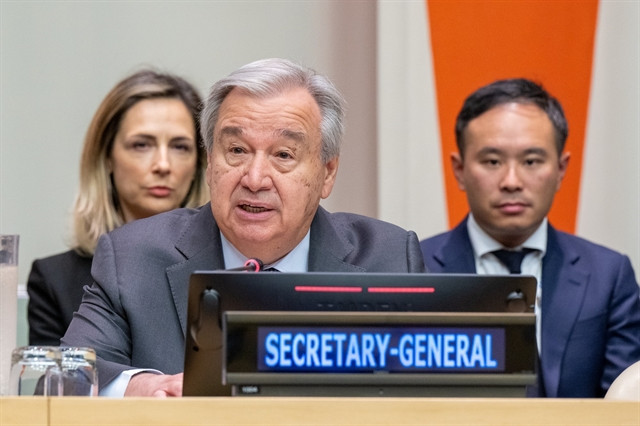 |
| UN Secretary-General Antonio Guterres speaks at the session. VNA/VNS Photo |
A treaty of the high seas was adopted by consensus and received a standing ovation during the United Nations meeting in New York on Monday.
Known as the Biodiversity Beyond National Jurisdiction Treaty, or BBNJ, but widely referred to as the High Seas Treaty, which has received widespread support from most countries, is key to protecting the ocean, promoting equity and fairness, tackling environmental degradation, fighting climate change, and preventing biodiversity loss in the high seas.
The adoption of this treaty is a historic achievement marking the successful end of more than a decade of multilateral work. This agreement is also a welcome addition to the United Nations Convention on the Law of the Sea (UNCLOS), which provides the legal framework under which all activities in the ocean take place.
UN member countries have expressed their intention to sign and ratify the agreement soon, aiming for its prompt entry into force and full implementation.
Cuba, representing the Group of Developing Countries, considers this outcome a triumph of diplomacy and multilateralism, a victory for developing nations achieved through the tireless efforts and close solidarity of the member states in the group.
Addressing the Conference, Ambassador Đặng Hoàng Giang, Head of the Permanent Delegation of Việt Nam to the United Nations and the Head of the Negotiating Delegation, affirmed that the successful results attained today reflected the strong commitment and determination of the Conference in establishing an instrument for the conservation and sustainable use of the seas beyond national jurisdiction.
The Ambassador emphasised that this treaty would further strengthen the 1982 United Nations Convention on the Law of the Sea (UNCLOS), which serves as the constitution of the oceans, providing a comprehensive legal framework for all activities at sea.
Additionally, he highlighted that this treaty "enhances multilateralism, represents a significant milestone in the development of international law, and contributes to the implementation of the Decade of Ocean Science for Sustainable Development and the realisation of the 14th Development Goal focused on marine conservation, sustainable use of oceans, seas, and marine resources."
In order to ensure the integrity of UNCLOS, during the future implementation of the treaty, Việt Nam and several other countries emphasised the importance of interpreting certain provisions in accordance with the agreement reached by the Intergovernmental Conference.
The adoption of the treaty by the United Nations has evoked strong emotions, particularly among those directly involved in the negotiations, including the Vietnamese inter-agency delegation chaired by the Ministry of Foreign Affairs and representatives from the Ministry of Natural Resources and Environment, the Ministry of Science and Technology, the Ministry of Agriculture and Rural Development, the Ministry of Public Security, the Việt Nam Academy of Sciences, and the Vietnamese Delegation in New York. This achievement is the culmination of a lengthy and complex process that was at times highly intense.
Rena Lee, Chairwoman of the Intergovernmental Conference, described the development of the agreement as "a monumental and crucial endeavour." When considering the preparatory activities for the Intergovernmental Conference and the advocacy efforts in the UN General Assembly, the entire process took nearly 20 years.
While UNCLOS guarantees freedom of navigation and freedom of fishing on the high seas beyond the exclusive economic zones, it also designates minerals in seabed areas on the continental shelf of countries as the common heritage of mankind. However, no similar mechanism exists for marine genetic resources. This high seas agreement provides a concrete and progressive development of UNCLOS in this regard. This agreement serves as the third instrument to implement UNCLOS, following the instrument on migratory fish stocks and the instrument to implement Part XI of the Convention.
The Agreement comprises 17 chapters, 76 articles, and two appendices, addressing various critical issues such as establishing a framework for "Marine Protected Areas", beyond the ones already within national territorial waters; establishing standards and guidelines to determine the environmental impacts of high seas activities, including their impact on marine life and ecosystems.
The treaty also creates a Conference of Parties (COP) to monitor and enforce compliance with the treaty's terms, which will include a scientific advisory board; while also creating a mechanism for the transfer of marine technology to developing countries to ensure equitable sharing of benefits and resources from the high seas. VNS